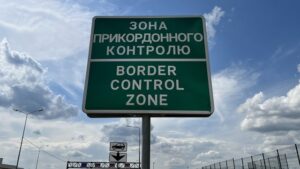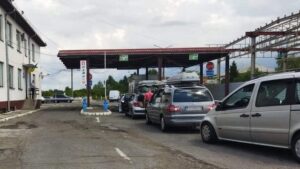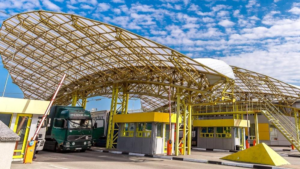
Passenger traffic across Ukraine’s border from August 16 to 22 amounted to 768,000, which is 1.3% less than the record level for wartime in the previous two weeks, according to data from the State Border Service on Facebook.
According to the data, while in the previous four weeks the number of people entering the country exceeded the number of people leaving by 15,000-32,000, with the approach of the new school year, the numbers evened out: the number of people leaving increased from 378,000 to 385,000, while the number of people entering decreased from 400,000 to 383,000.
The number of vehicles that passed through checkpoints this week increased from 144,000 to 145,000, while the flow of vehicles carrying humanitarian cargo decreased from 524 to 449.
This Sunday, as of 9:00 a.m., according to the State Border Service, the longest queue of 55 cars and 4 buses was at the Ustyluh checkpoint on the border with Poland. Forty cars and four buses were waiting to cross the border at the Krakivets checkpoint, while 19 buses had accumulated at the Shehyni checkpoint.
On the border with Hungary, the longest queue of 45 cars was at the Kosyno crossing, while at the Luzhanka checkpoint there were 30 cars, at Dzvinkove – 20, and at Tisa – 15.
At the border with Slovakia, 30 and 20 cars were waiting for inspection at the Uzhhorod and Malyi Berezny checkpoints, respectively, while at the border with Romania, there was only a queue of 30 cars at the Dyakove checkpoint.
The total number of people crossing the border this year is 4.2% higher than last year: during the same seven days last year, 370,000 people left Ukraine and 367,000 entered, and the flow of cars was also lower – 133,000.
As reported, from May 10, 2022, the outflow of refugees from Ukraine, which began with the start of the war, was replaced by an influx that lasted until September 23, 2022, and amounted to 409,000 people. However, since the end of September, possibly influenced by news of mobilization in Russia and “pseudo-referendums” in the occupied territories, followed by massive shelling of energy infrastructure, the number of those leaving exceeded the number of those entering. In total, from the end of September 2022 to the first anniversary of the full-scale war, it reached 223,000 people.
During the second year of the full-scale war, the number of border crossings to leave Ukraine, according to the State Border Service, exceeded the number of crossings to enter by 25,000, during the third year by 187,000, and since the beginning of the fourth year by 116,000, of which 80,000 were seasonal since the beginning of summer.
As Deputy Minister of Economy Serhiy Sobolev noted in early March 2023, the return of every 100,000 Ukrainians home results in a 0.5% increase in GDP.
In its July inflation report, the National Bank of Ukraine worsened its migration forecast: while in April it expected a net inflow of 0.2 million people to Ukraine in 2026, it now forecasts a net outflow of 0.2 million, which corresponds to this year’s estimate of net outflow. “Net returns will only begin in 2027 (about 0.1 million people, compared to 0.5 million in the previous forecast),” the NBU added. In absolute terms, the National Bank estimates the number of migrants currently remaining abroad at about 5.8 million.
According to updated UNHCR data, the number of Ukrainian refugees in Europe as of July 31, 2025, was estimated at 5.115 million (as of July 1 – 5.083 million), and worldwide – at 5.676 million (5.643 million).
In Ukraine itself, according to the latest UN data for April this year, there are 3.757 million internally displaced persons (IDPs), compared to 3.669 million at the end of last year.

The State Border Service of Ukraine reports a 40% increase in passenger traffic through checkpoints in the Lviv region on the border with Poland since the start of the summer season, and on weekends – by another 16% compared to weekdays.
“One of the busiest checkpoints remains Shehyni due to repair work on the Ukrainian side,” the agency said in a Telegram channel on Thursday.
In particular, 150 cars have gathered at this checkpoint, 100 at the Krakivets checkpoint, 30 at the Hrushev checkpoint, 25 at the Uhryniv checkpoint, and 10 at the Nyzhankovychi checkpoint. Only the Smilnytsia and Rava-Ruska checkpoints are operating without delays.
“To speed up the processing of citizens, border guards have stepped up their work: during peak hours, the number of patrols has been increased and additional automated workstations have been deployed. Regular meetings are also held with Polish colleagues to jointly seek solutions that will help speed up border crossings,” the State Border Service said.
As reported, passenger traffic across the Ukrainian border during the week of July 26 to August 1 increased by 1.7% to 766,000, setting a new record for wartime: last year, record figures were recorded in August and amounted to 737,000. The outbound flow in the ninth week of summer remained almost unchanged at 367,000 compared to 369,000 a week ago, while the inbound flow increased from 384,000 to 399,000.

Passenger traffic across the Ukrainian border during the week of June 7-13, with the onset of summer, the end of the school year, and the start of the vacation season, increased by another 3% to 590,000, according to data from the State Border Service on Facebook.
According to the data, the outbound flow increased from 311,000 to 324,000, while the inbound flow increased from 262,000 to 266,000.
The number of vehicles that passed through checkpoints this week increased from 125,000 to 127,000, while the flow of vehicles carrying humanitarian cargo remained at 514.
During the week, the State Border Service reported an increase in passenger traffic across the Ukrainian border and the resulting queues.
“The heaviest traffic is observed at the end of the week and on weekends,” the agency said.
According to the State Border Service, at noon on Sunday, the longest queue of passenger cars at the Polish border was at the Ustyluh checkpoint, with 80 vehicles, while 15 cars were waiting to cross the border at Uzhgorod and Shehyni, and 10 at Krakivets.
At the border with Hungary, there were queues of 20-25 cars at all crossing points – Vylok, Luzhanka, Tisa, Dzvinove, and Kosino.
At the border with Slovakia, 40 cars were waiting to pass inspection at the Uzhgorod checkpoint, and 15 at Maly Berezny.
At the border with Romania, there was a queue of 50 cars at the main crossing point “Porubne.”
The total number of people crossing the border this year is higher than last year: during the same seven days last year, 306,000 people left Ukraine and 268,000 entered, and the flow of cars was also lower – 119,000.
Last year, a significant summer increase in passenger traffic began in the first week of June and lasted for five weeks in a row.
As reported, from May 10, 2022, the outflow of refugees from Ukraine, which began with the start of the war, was replaced by an influx that lasted until September 23, 2022, and amounted to 409,000 people. However, since the end of September, possibly influenced by news of mobilization in Russia and “pseudo-referendums” in the occupied territories, followed by massive shelling of energy infrastructure, the number of people leaving exceeded the number of people entering. In total, from the end of September 2022 to the first anniversary of the full-scale war, it reached 223,000 people.
During the second year of the full-scale war, the number of border crossings to leave Ukraine, according to the State Border Service, exceeded the number of crossings to enter by 25,000, during the third year by 187,000, and since the beginning of the fourth year by 137,000.
As Deputy Minister of Economy Serhiy Sobolev noted in early March 2023, the return of every 100,000 Ukrainians home results in a 0.5% increase in GDP.
In its April inflation report, the National Bank again estimated the outflow from Ukraine in 2024 at 0.5 million (according to the State Border Service – 0.315 million). In absolute terms, this means an increase in the number of migrants remaining abroad to 6.8 million in 2024. The NBU also maintained its forecast for the outflow in 2025 at 0.2 million.
According to updated UNHCR data, the number of Ukrainian refugees in Europe as of May 31, 2025, was estimated at 5.059 million (as of April 17 – 6.358 million), and worldwide – at 5.620 million (6.918 million).
In Ukraine itself, according to the latest UN data at the end of last year, there were 3.669 million internally displaced persons (IDPs).

Passenger traffic across the Ukrainian border during the week from May 31 to June 6, with the onset of summer, the end of the school year, and the start of the vacation season, increased by 13.2% to 573,000, according to data from the State Border Service on Facebook.
According to the data, the outbound flow jumped from 253,000 to 311,000, while the inbound flow increased from 253,000 to 262,000.
The number of vehicles that passed through checkpoints this week did not increase significantly, from 124,000 to 125,000, and the flow of vehicles carrying humanitarian cargo even decreased slightly, from 524 to 514.
According to the agency, at noon on Sunday, there was only one queue of passenger cars at the Ustyluh checkpoint on the Polish border, with 30 vehicles, while four buses were waiting to cross the border at Shehyni.
At all other checkpoints, there were queues of 15 and 10 vehicles at the Vylok and Luzhanka checkpoints on the border with Hungary and 10 vehicles at the Uzhgorod and Maly Berezny checkpoints on the border with Slovakia.
The total number of people crossing the border this year is higher than last year: during the same seven days last year, 291,000 people left Ukraine and 251,000 entered, and the flow of cars was also lower – 118,000.
Last year, a significant summer increase in passenger traffic began in the first week of June and lasted for five weeks in a row.
As reported, from May 10, 2022, the outflow of refugees from Ukraine, which began with the start of the war, was replaced by an influx that lasted until September 23, 2022, and amounted to 409,000 people. However, since the end of September, possibly influenced by news of mobilization in Russia and “pseudo-referendums” in the occupied territories, followed by massive shelling of energy infrastructure, the number of departures exceeded the number of arrivals. In total, from the end of September 2022 to the first anniversary of the full-scale war, it reached 223,000 people.
During the second year of the full-scale war, the number of border crossings to leave Ukraine, according to the State Border Service, exceeded the number of crossings to enter by 25,000, during the third year by 187,000, and since the beginning of the fourth year by 79,000.
As Deputy Minister of Economy Serhiy Sobolev noted in early March 2023, the return of every 100,000 Ukrainians home results in a 0.5% increase in GDP.
In its April inflation report, the National Bank again estimated the outflow from Ukraine in 2024 at 0.5 million (according to the State Border Service – 0.315 million). In absolute terms, this means an increase in the number of migrants remaining abroad in 2024 to 6.8 million. The NBU also maintained its forecast for outflow in 2025 at 0.2 million.
According to updated UNHCR data, the number of Ukrainian refugees in Europe as of April 17, 2025, was estimated at 6.358 million, and worldwide at 6.918 million, which is 15,000 fewer than on March 20.
In Ukraine itself, according to the latest UN data at the end of last year, there were 3.669 million internally displaced persons (IDPs).

The multimodal terminal of the Fiska-Nov company will be launched in the territory of the Hlybotska community (Chernivtsi region), near the border with Romania, the community’s press service reported.
“The launch of this terminal will be an important step in the development of transport infrastructure, increase the transit potential of the region, and contribute to economic growth at both the local and national levels. In addition, its location near the border with Romania gives it strategic importance for transportation between Ukraine and the European Union,” the community said.
The facility’s infrastructure includes six railway tracks and special equipment that allows for transshipment between Ukrainian 1,520 mm gauge and European 1,435 mm gauge railcars. The terminal will also accept cargo by road. The purchased and installed load cells are designed to ensure accurate weight control of cargo during loading and unloading.
The Fiska-Nov company plans to create about 100 new jobs.
Oleg Nivievsky, Chairman of the Center for Food and Land Use Research at the Kyiv School of Economics, praised the community’s initiative on Telegram, which took advantage of the feasibility study developed by KSE in 2023 for the construction of a dry port on the border with Poland.
“The result was quite unexpected but pleasant — such projects are economically viable even without state support. Why is this important? Because improving and increasing the capacity of communications with the EU is a kind of insurance against a ‘crazy’ neighbor. In other words, it is something that can be supported with taxpayers’ money, but here the result is that everything looks good without support,” the scientist summed up.

Polish carriers have announced a new protest action on the border with Ukraine. This was announced by the Committee for the Protection of Transport Carriers and Employers of Poland, which submitted an official request to hold the event near the Dorohusk-Yagodin checkpoint, one of the largest between the two countries.
According to the organizers, the decision to resume protests is related to the Polish government’s lack of response to the demands of representatives of the transport industry.
“We have registered a protest at the largest border crossing point. Disappointed by the inaction of the authorities, we want to restore the balance in the transport market, which was disrupted after the cancellation of permits for Ukrainian carriers,” the Committee said in a statement.
At the moment, the date and duration of the protest have not been specified.
Context: ongoing tensions at the border
Protests by Polish carriers and farmers on the border with Ukraine have been ongoing since November 2023. The main demands of the participants are the return of the permit system for Ukrainian carriers, a ban on imports of Ukrainian products, state subsidies for fertilizers, compensation for fuel excise taxes, and immediate payment of subsidies.
In some cases, the protests have led to the effective blockade of border crossing points, creating long queues and significant disruptions to logistics.
Restrictions at the border
In addition to possible protests, capacity at a number of border crossing points is limited due to repair work:
From April 24 to mid-July, work is being carried out at the Medyka-Shehyni border crossing point;
From April 30 to June 5, at the Ustyluh-Zosin checkpoint;
From May 8 to mid-June, at the Korcheva-Krakovets checkpoint.
In addition, a new road checkpoint, Nizhankovychi-Malhovychi, has been operating since the end of 2024, open to passenger and freight transport.
History of border blockades
The first large-scale stage of protests by Polish farmers and carriers began in the fall of 2023. Over the following months, they repeatedly blocked key border crossings, including Yagodyn, Rava-Ruska, Krakivets, and Shehyni. The protests were accompanied by political rhetoric and discontent over the expanded access of Ukrainian carriers to the EU without permits, which caused concern among Polish trade unions.
Despite temporary agreements between the Ukrainian and Polish authorities, tensions at the border remain high. Experts note that the situation requires a systemic political and economic solution, including the renewal of agreements and the easing of competitive tensions between the countries.